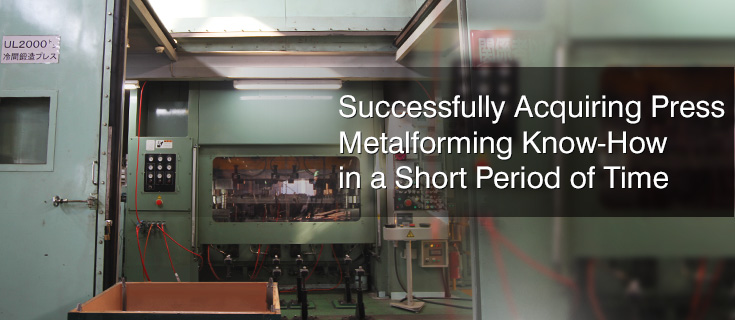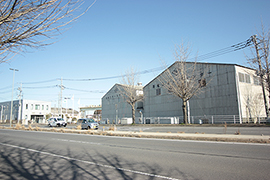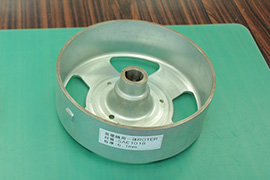These are links for moving within this page
- Text Size
-
- Standard
- Large
These are links for moving within this page
It is the main content from here.

![[About the Customer]Ibaraki Steel Center Co., Ltd. A manufacturer utilizing press metalforming and shear forming processes, located in Naka City, Ibaraki Prefecture.This company specializes in the integrated forming of thick materials using methods ranging from flame cutting and shearing to cold forging. Its strength lies in jointly researching the materials suitable for the forming application with its suppliers in order to find and use materials that won't break and have the requisite elongation ratios, and it leverages this strength to form products that are used in a wide range of fields.](/en/technology/development/voice/images/ibaraki-sc_ph01.jpg)

For approximately the first 20 years of our company we specialized in shear forming, but the catalyst for venturing into press metalforming occurred in 1990 when we took on some blanking work from one of our major customers. In 2006 we purchased an AIDA UL-20000 high-precision forming press and began doing cold forging work, and we have put into place the systems that have made us a full-scale press parts manufacturer.
Though our company does not have a long history of press stamping--and especially of cold forging--I feel that the reason we were able to acquire the know-how in such a short period of time was in a large part due to the help we received from AIDA. At any rate, up to that time we didn't have any experience with cold forging, and AIDA taught us the basics--from how to select die materials to how to create process drawings.

We started cold forging in 2008 and it was 2 years later--in 2010--that we began the mass production of rotors for residential power generators. And it was AIDA that helped us with the process development. The conventional method was to make two separate parts--a yoke and a hub--and after press-fitting some rivets we would use a staking operation to join these two separate parts that were produced using different materials and different forming methods. However, we succeeded in using an integrated internal system of blanking->shot-blasting and bonderizing->cold forging to mass produce them as single parts while using more commonly available materials.
Achieving the equivalent hardness characteristics of conventionally produced parts requires first thickening the material and then striking it. But if you strike it too hard the material will crack, and this was something that we struggled to control. Another challenge was assuring the precision of the part, because if the forming precision is poor it ends up picking up sounds from even the smallest vibrations.
The way we went about it was to create process concepts and matching die assembly drawings and then give them to AIDA to review and provide feedback. Once we reached the point where we had a fairly firm process plan in place, AIDA recommended that we do die trials using actual dies, and that really ended up being a big help.
Our company had originally drafted a plan for completing the forming of this single part using approximately 6 process steps, but as a result of the trials we found out that it was difficult to assure the hub strength and roundness accuracy that the customer required. Moreover, in the middle of the development process the customer made further requests such as 'The hub strength appears to be a bit weak, so please make it harder by striking it more forcefully,' and 'When the yoke openings are being stamped the roundness accuracy loses its stability, so we want you to improve this accuracy as much as possible.' So we spent about a year and ended up changing the forming methods over 20 times, and in the end we were able to successfully form the part in 10 process steps (3+3+4) and keep the roundness accuracy of the Ø190 mm circle circumference within 0.001 mm while still maintaining the requisite strength.
If we had just done a study based on drawings, there is no question that it would have taken much longer to develop the forming method. We learned a lot through this process, such as how to classify process steps by their elements when splitting up processes, how to design with a specific goal in mind, and the importance of maintaining detailed data records of the trial results so that this data can be leveraged in later process development.
Of all the technical support we received from AIDA, what we valued the most was that AIDA would not provide solutions on the spot, rather they provided ongoing proactive assistance that enabled us to bolster our own internal engineering expertise. For example, when we would run up against process design issues, AIDA would give us advice but not the solution. Though we would have gotten through the problem at hand if they had done so, the technical expertise would not have remained as part of our own company. It is exactly for this reason that AIDA would not go so far as to simply tell us the solution. And our company is truly endebted to AIDA for providing the sound advice we needed for developing production processes, etc.
Thank you very much. Please let us know if there is anything further we can do to assist you in growing your company.